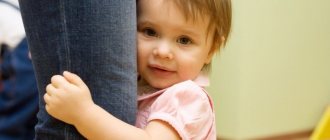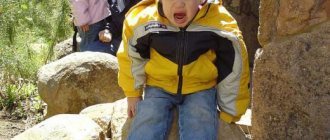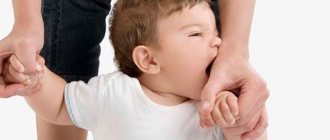The beginning of autumn for many children and their parents is closely connected not only with pleasant and exciting moments of preparation for school life, but also with the difficult transition of a child from the status of a preschooler to the status of a schoolchild; from primary school student to middle school student. In both cases, most parents are faced with psychological and social problems associated with the new stage in their children’s lives - adaptation to school and adaptation to the new conditions of the usual school. The answer to the question “How to go through this path with minimal costs for the health of your children and for the nervous system of your parents?” - look in this article.
Content:
- Adaptation period
- Stages of adaptation
- Features of adaptation of first-graders
- Features of adaptation of schoolchildren (fifth graders) to the secondary level
- Types of adaptation Social and psychological adaptation
- Physiological adaptation
- Signs of successful adaptation
- Psychologist's advice
Anxiety test
To determine the level of anxiety in a first-grader, it is proposed to conduct a survey of teachers and parents, more details.
When summing up the results, it is necessary to calculate the total score, which sums up the results of both surveys.
a “Good-Bad Chart” test to determine a child’s emotional problems
There is another projective method for diagnosing school anxiety that is similar in its direction (A.M. Prikhozhan).
Adaptation period
What is “child adaptation to school”? In the broadest sense of the word, adaptation is adaptation to environmental conditions. Adaptation to school is getting used to systematic learning and new school conditions. According to psychologists, adaptation can last from 6-8 weeks to six months , and sometimes more. Why does the duration of this process vary so much among children? The adaptation period is associated with many factors: the “atmosphere” in the family, the child’s personal characteristics, the level of his knowledge and skills, the type of educational institution, the level of complexity of the program, etc.
“Ladder” technique
To determine the level of self-esteem of a child when diagnosing the adaptation of first-graders to school, it is recommended to use the “Ladder” technique. To carry it out, you need to prepare a drawing of a staircase with numbered steps.
The child is invited to familiarize himself with this arrangement of schoolchildren on the steps:
- 1 - the nicest guys;
- 2 and 3 - good;
- on 4 - neither good nor bad;
- 5 and 6 - bad;
- at 7 - the worst.
The first grader must indicate the step on which, in his opinion, he himself should be. You can draw a circle on this step or put another mark. There is no need to focus on the numbering of steps when conducting the test. It is desirable that the same ladder be drawn on the board, and the psychologist would simply point to each step and explain its meaning, and the children would simply correlate it with their image.
The results are assessed as follows:
- 1 - inflated self-esteem;
- 2 and 3 - adequate;
- 4 - underestimated;
- 5 and 6 - bad;
- 7 - sharply underestimated.
This technique can be replaced with a similar test “Mugs” .
Also, to determine the level of self-esteem of a first-grader, you can use the method of studying adaptation the Luscher method , which is carried out using special forms.
Stages of adaptation
Conventionally, the process of a child’s adaptation to school is usually divided into three main stages, each of which has its own characteristics.
The first stage of adaptation is called “Tentative”
The child takes a closer look at new conditions, studies the situation, boundaries, norms, etc. This is quite difficult for him. The child is often tense: both physically and psychologically. Reactions can be brightly colored and harsh.
The stage lasts, most often, about two to three weeks.
The second stage is the stage of “Unstable adaptation”
The name speaks for itself: the child begins to adapt. He is already close to finding optimal behavior under the proposed conditions. Behavior patterns are built in a small head - this allows the body to expend less energy than at the first stage. Reactions are already less emotionally charged.
Duration: about two to three weeks.
The third stage of adaptation – “Relatively stable adaptation”
At this stage, the child gains confidence in the chosen forms of behavior, they become stable; there is a final assessment of the concept “I am a schoolboy, and what does that mean”...
The last stage lasts from five to six weeks to a year.
Features of adaptation of first-graders
A child’s adaptation to school life is a complex and multifaceted process, thanks to which the child adapts to new conditions and a new status. The harmonious course of the process is impossible without the help of an adult, from whom explanations and clarifications are expected, as well as help, words of support or just a hug. A parent must understand that the adaptation process is temporary, and the duration of adaptation and the further success of his child’s education depends on how much effort he, the parent, puts in.
In many ways, a child’s adaptation to school depends on the classroom environment. If a younger student is comfortable, interested and not scared, this makes the process easier.
A friendly atmosphere in the classroom is the main task of the teacher during this period. At this time, the child experiences increased anxiety, internal tension, and self-esteem becomes low. It is important to give the child the opportunity to work in a mode that is convenient for him. The teacher should be calm and restrained, pay attention to the successes and achievements of the children. If the teacher does not take into account the specifics of this period, this can lead the child to a nervous breakdown. Therefore, it is so important to monitor the physical and mental health of a first-grader.
If a parent has doubts that his child’s adaptation is difficult, then he should definitely talk to the teacher. In addition, it is important not to hesitate to seek help from specialists from an educational institution (psychologists, speech therapists, medical workers, etc.)
Are you afraid for your young schoolchild? Check whether everything is going well for him at school, whether his peers or teachers are offending him, and whether the difficult period of adaptation is going smoothly. Download the “Where are my children” application from the AppStore and GooglePlay stores.
Test "Houses"
Another method for diagnosing first-graders’ adaptation to school is the “Houses” test. It is carried out to determine:
- value orientations;
- social emotions;
- personal relationships.
This test is a color association study. The author of the test is O.A. Orekhova. To carry it out you need to prepare:
- questionnaire;
- 8 pencils (black, grey, brown, purple, blue, green, yellow, red).
Pencils should not look different from each other.
For the study, you need to invite a group of children (10-15 people) and seat them separately from each other. It is imperative that the teacher is not present in the classroom during the diagnosis. Children must complete three tasks.
Exercise 1.
There is a picture of a house, to which a path of 8 rectangles leads. First graders are asked to color them in order, and each color can only be used once. First you need to choose the color you like best and decorate the first rectangle. Next, take the color that you like best among the remaining ones. The last rectangle will be painted with the ugliest color, in the child’s opinion.
Task 2.
Children will color a picture that shows a street with several houses. The psychologist should explain that different feelings live in these houses and children need to choose for each of them the color with which they are associated when naming such words: happiness, grief, justice, resentment, friendship, quarrel, kindness, anger, boredom, admiration .
In this task, the same color can be used several times. If schoolchildren do not understand the meaning of any of the named words, then the psychologist explains it.
Task 3.
The picture used is the same as in the previous task. Now the children must decorate the houses in a color that symbolizes their inhabitants. The soul of a child lives in the first house. The inhabitants of houses 2-9 are responsible for his mood in such situations:
- when he goes to school;
- in a reading lesson;
- in a writing lesson;
- in a math lesson;
- when communicating with the teacher;
- when communicating with classmates;
- when he is at home;
- when doing homework.
In the tenth house, the child must himself accommodate any “colored” tenant, who will signify his special condition in a situation that is important to him personally. After completing this task, each first grader must tell the psychologist what exactly this tenth house means to him (it is better to do this so that the other children do not hear), and he makes a corresponding note on the questionnaire.
When summing up the results of this diagnosis of adaptation of first-graders, the psychologist should focus on the following numbering of colors: 1 - blue, 2 - green, 3 - red, 4 - yellow, 5 - purple, 6 - brown, 7 - black, 0 - gray.
To avoid having to do such complex calculations yourself, you can try to find a special program on the Internet designed to process the results of this test.
Features of adaptation of schoolchildren (fifth graders) to the secondary level
Any student moving from primary to secondary school faces another period - adaptation to the new conditions of an already familiar school. This moment can be called a turning point mainly because it coincides with crisis age-related changes: the child is no longer a junior school student, he becomes a teenager. At this time, a new personal formation begins to actively form - gaining a sense of adulthood and finding oneself as an individual. This process is quite painful and leads to the fact that the child begins to isolate himself from loved ones, who until that time played the most important role in his life. This manifests itself in the fact that the teenager resists any interference in his life and often goes against the feelings and desires of adults.
Now the teenager is ready to build new relationships with peers. It is through friendships that a child develops models of social relationships, moral values, etc.
During this period, the child’s self-esteem also undergoes changes. Previously, it was directly related to educational activities, the level of knowledge and the assessment of this knowledge by the teacher. Now the main criterion for self-esteem is the level of communication with peers. Communication becomes the leading activity.
Against this background, educational motivation decreases, academic performance falls, and conflicts with teachers occur.
Parents should remember that the mental activity of adolescents during this period is quite high. But its development now directly depends on the emotions that the child experiences during learning.
Success or failure has a significant impact on learning motivation. After all, a high score “confirms” the teenager’s capabilities. The ideal moment is when “assessment” and self-esteem coincide. If this does not happen, there is an increase in internal discomfort, which over time can develop into internal conflict.
That is, when a child moves from the primary stage of schooling to the secondary level, he undergoes not only external changes, but also deep, internal ones.
Types of adaptation
There are two main types of child adaptation to school:
Socio-psychological adaptation
When a child goes to first grade, he acquires a new status - a school student. Along with the change in status, a reassessment of values occurs: everything related to educational activities becomes important. The child finds himself in a new team, he is surrounded by unfamiliar faces. At this point, the teacher and parent play an important role. They help set the child up for a positive emotional attitude towards school.
To go through the adaptation period harmoniously, it is important to pay special attention to the following skills:
Cognitive abilities
The development of cognitive abilities in most children is a natural process. But this does not mean that you should not pay attention to more successful development of this skill. In older preschool age, this skill develops in parallel with memory, attention, thinking and cognitive interests. If all of the above processes develop harmoniously, adaptation will occur faster and the student’s body will expend less energy.
Creative thinking
Nowadays it is important to think “not like everyone else.” The meaning of the concept of “black sheep” is now changing dramatically. The attitude towards people with bright creative thinking is also changing. Parents should not be scared if their child knows how to be “creative” and think outside the box. In the future, this may be a good help for getting out of some critical situations.
Self-organization
When starting school, the child finds himself in a system where strict time limits work: lessons, breaks, additional tasks - all at a certain time. The ability to manage and distribute your time is a very important skill for a first grader.
In addition, the development of logic, imagination, and communication is important.
Physiological adaptation
A huge physical load falls on the shoulders of a schoolchild: mental in the form of mastering new knowledge and physical - a static position during the educational process. The greater the load, the more energy the body expends. It is important not to miss the moment of fatigue.
Difficulties and problems that schoolchildren and their parents may encounter
It is advisable for parents of future first-graders to know the main difficulties and problems that can await them in elementary school:
The problem of waking up in the morning
In the first days of school, especially if the child liked it at school, he wakes up without any difficulties. Over time, the first interest in school dulls, routine begins and the process of awakening may not be so simple. Often, it is in the morning hours, before school, that a child has hysterics. One of the ways to harmoniously overcome this problem is considered to be “gradual awakening.” This means that the child needs to be woken up not abruptly, but gradually, with a temporary reserve that will allow him to “soak up” in bed.
“I want it like Sashka’s!”
A new student, in addition to the learning process and preparing homework, actively communicates with peers. There is a high probability that he can see another boy/girl with a beautiful backpack, a cool iPhone and understand that he wants the same one. Here, parents are faced with a difficult choice: to find an opportunity to make a purchase for their child so as not to “be worse than others” or not to follow the child’s lead, but in this case he may feel insecure.
How to harmoniously get out of such a situation when a child, coming home from school, declares: “I want a tablet like Sashka’s!”? The best option: invite the student to save money. By doing this, you instill a competent attitude towards money, and give the child the “opportunity” to make a final decision over time: “Is this really necessary or is it better to buy something else?”
Dangerous homework
It is very important for your child to do his homework independently! A parent can always help, but only after asking for it. Support from the parent's side at this moment is mandatory: he can simply be in the room, help reformulate the complex into simple, but not do the work for the child. The primary task of an adult is to help organize the learning space: where textbooks and notebooks, pens and pencils, etc. will be placed.
Allowing your child to be independent does not mean letting everything take its course: you can control the situation without imposing. This is how you let your child know: “I trust you!” and “You can do anything!”
Conditions for successful adaptation
The most successful adaptation conditions include:
- having a complete family;
- high level of parental education;
- adequate methods of education;
- respect for the rights of the child;
- the child's readiness for school;
- positive attitude in the family towards the status of a student.
Signs of successful adaptation:
Satisfaction with the learning process
The child happily talks about school and attends it with pleasure.
Mastering the program
It is not particularly difficult for the child to cope with the assigned tasks. If a child works according to the traditional program, but experiences some difficulties, it is important to support him without comparing him with other children, without reproaching him or pointing out his shortcomings. If difficulties arise when studying within a complex program (for example, with in-depth study of a subject), parents should consider switching to a regular program.
Degree of independence
The child must complete the tasks independently; after unsuccessful attempts, he may ask an adult for help. Many adults start helping from the very beginning - and this is a big mistake. The child quickly gets used to this option of preparing homework and in the future it will be more difficult for him to complete it independently.
Satisfaction with relationships with teacher and classmates
This is one of the main signs. If a child has a harmonious relationship with the teacher and classmates, the adaptation process will take place at the lowest cost.
Observation
The most common diagnostic method is observation. The most commonly used method is sample observation. During its implementation, only those features of the child’s behavior are recorded that distinguish him from the general mass of first-graders. Observation is carried out simultaneously for all children in the class. Basic requirements for organizing surveillance:
- presence of an observation scheme;
- systematic;
- objectivity.
Observation should also include:
- analysis of the child’s progress;
- viewing notebooks;
- listening to oral responses;
- analysis of existing interpersonal relationships.
As a result of observations, the main seven components are assessed (on a 5-point scale):
- educational activity;
- mastering program materials;
- behavior in lessons;
- behavior during breaks;
- relationships with classmates;
- relationship with the teacher;
- emotions.
The corresponding scores and conclusions must be entered into the school adaptation card.
The total points can be interpreted as follows:
- 35 – 28 – high level of adaptation;
- 27 – 21 – average;
- 20 or less is low.
To conduct observations during the adaptation period, you can use Stott's map , which provides for the study of asociality, infantility, subordination, activity and uncertainty.
Factor Asociality, Infantility, Subordination, Activity, Uncertainty - see here.
With this method, the overall score is not displayed, but each criterion is assessed separately. After this, groups of children with the highest (above 65%) scores for each factor are determined.
General recommendations for parents
Psychologist's advice
Praise
Every mother, helping her child do his homework, notices his mistakes. But you really want your child to write and complete all assignments correctly! At this moment, the mother’s inner critic, solely out of love for the child, begins to find fault, pointing out mistakes...
It is important for a parent to notice what the child does well and to focus on it. This will give confidence - the student will have the desire and desire to do better!
Does your child not want to do homework or is it difficult to get him to sit down for his homework? Find the right motivation for your student. Together, come up with a desired goal for which the child will save by completing certain tasks from the parent. The “Where are my children” application and the new “Children’s Tasks” feature help you do this!
Working hours when preparing homework
In order to understand how best to approach homework, parents need to observe their child and answer a few questions:
- Is it easy for the child to “get involved in work”?
- how long does it take to “accelerate”?
- How long after switching on can it work without getting tired?
- How quickly does exhaustion set in?
For those children who have difficulty getting involved in homework, it is better to start with literary reading. And for those who quickly become exhausted, start with math and be sure to take breaks.
Don't demand too much!
It is important for a parent to understand and be aware of the child’s capabilities. To do this, you can simply observe: what a beginning student does well and what not so well. Set “goals” gently, slightly above the child’s capabilities or in accordance with them.
Bet on Confidence
It is very important for mom and dad to know the “strengths” of their beginning student. To do this, answer yourself these questions:
- “What admires me about my child?”;
- “What can he do well?”
When helping your child become a confident student, rely on what he is strong at.
Afterword
School adaptation is a crisis situation, since the child finds himself in new conditions without the appropriate “tools” and experience of similar situations. Studying in the first grade coincides with the 7-year crisis. This makes the adaptation process even more difficult. The period of school adaptation can be called a contradictory period of transformation of a preschooler into a schoolchild.
If the child is ready for school and has the support of the family and teacher, school adaptation can take place in 2-3 months. Otherwise, the process may last for a year and be accompanied by problems or result in maladaptation (the child’s inability to psychologically and physically accept a new way of life).
The democratic style of education has a beneficial effect on the development of the child and his adaptation to any conditions. Child-parent relationships in which each family member acts as an active subject, is interested in the affairs of others, supports, is involved in everything that happens and expects the same from others.
—>
The concept of adaptation (from the Latin word adapto-adapt) arose in biology and is considered in it as the adaptation of the structures and functions of the body, its organs and cells to environmental conditions. Social adaptation is considered as an individual’s adaptation to the conditions of the social environment; it is one of the main socio-psychological mechanisms of personality socialization, which includes the individual’s acceptance of a social role.
Social adaptation includes:
- adequate perception of the surrounding reality and oneself;
- successful communication and adequate relationships with others;
- ability to work, study and organize leisure and recreation;
- ability for self-service and self-organization;
- variability of behavior in accordance with role expectations.
The importance of social adaptation increases in conditions of a radical change in a person’s activity and social environment. For students in first, fifth, and tenth grades, their social environment (new class composition and/or teachers) and system of activity (content of the new level of education) changes. The situation of novelty is always alarming to one degree or another for a person. In such conditions, the child experiences emotional discomfort due to the uncertainty of ideas about the requirements of teachers, the characteristics and conditions of education, the values and norms of behavior in the class team, etc. This state is often accompanied by internal tension, which sometimes makes it difficult to make both intellectual and personal decisions . Sufficiently long-term mental stress can result in school maladaptation and the child then becomes undisciplined, inattentive, irresponsible, lags behind in studies, gets tired quickly and no longer wants to go to school. Somatically weakened children (and their number is increasing) are the most susceptible to maladjustment.
Of course, a child’s adequate perception of his school environment and successful establishment of relationships with classmates and new teachers are very difficult if he has a high level of personal and school anxiety. Thus, the learning process itself becomes more complicated, and productive work in the classroom becomes problematic. Even a potential excellent student can turn into a struggling student.
The process of adaptation of students becomes no less important for teachers who, knowing little about their students, may make mistakes in assessing their capabilities, successful individualization and differentiation of learning. Therefore, teachers need to timely adjust their own pedagogical position regarding the class and individual students.
InterpretationTranslation LEVEL OF ADAPTATION Neutral position in the sensory continuum; in special usage: the level to which the sense organ has adapted. Based on this concept, Harry Helson developed a whole theory of sensory-contextual influences. This theory states that neutral stimuli to which the subject has already adapted provide the background against which new stimuli are perceived. Thus, for example, cool water may feel warm if the subject has previously adapted to fairly cold water. Although the theory was developed in relation to sensory processes, it has been widely used in areas far from the sensory continuum, especially in the study of attitudes and changes in attitudes.
Explanatory dictionary of psychology. 2013.
Other books on request “ADAPTATION LEVEL” >>Sources used:
- https://studwood.ru/675093/psihologiya/urovni_vidy_protsessa_adaptatsii
- https://psychologist.tips/849-psihologicheskie-osobennosti-adaptatsii-rebenka-k-shkole-vidy-i-urovni-adaptatsii.html
- https://studopedia.ru/9_221824_ponyatie-i-osobennosti-adaptatsii.html
- https://psychology_dictionary.academic.ru/8614/adaptation_level









